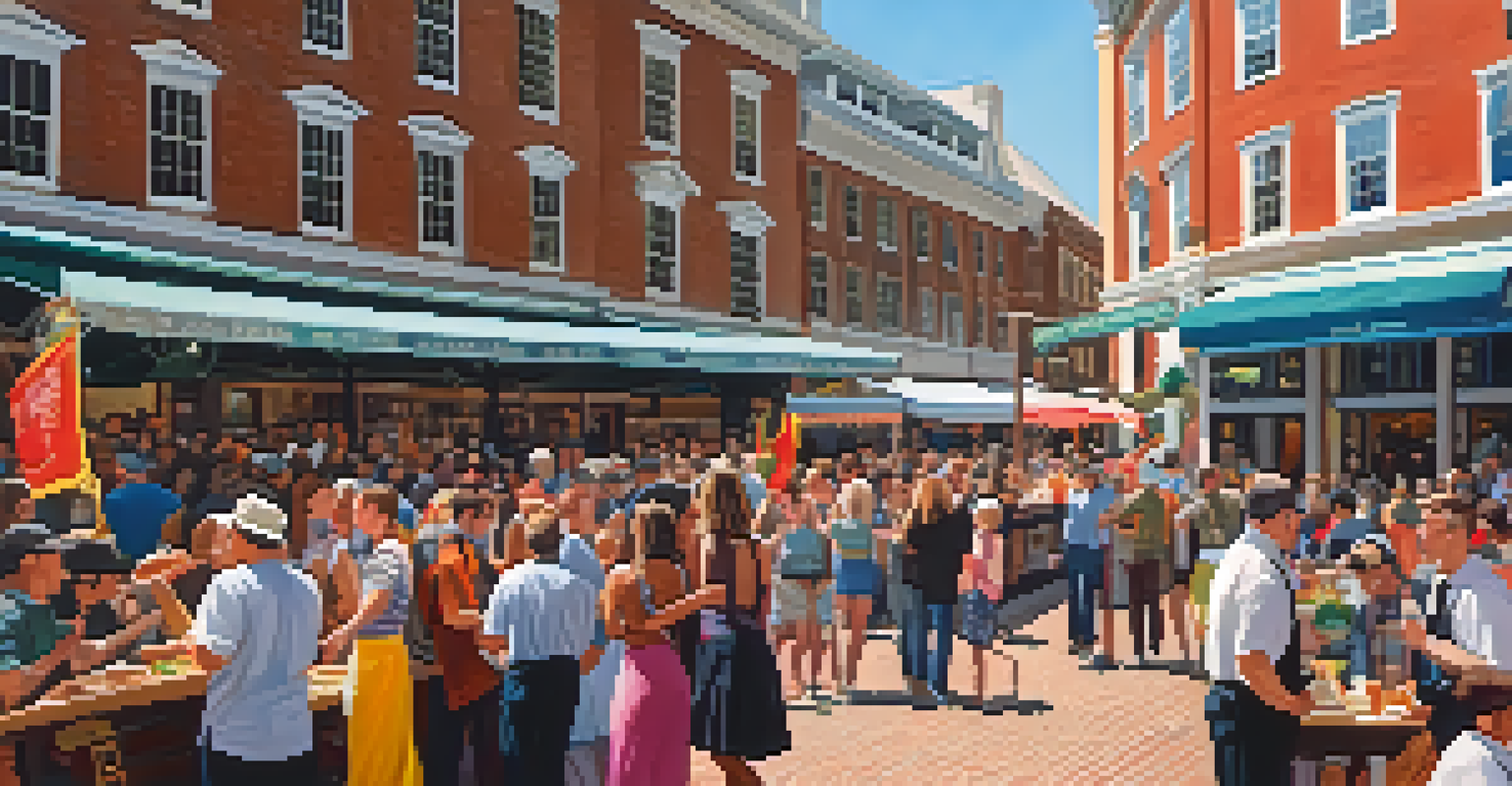Boston's Freedom Trail: A Path Through American History

Introduction to the Freedom Trail: A Historical Journey
The Freedom Trail is more than just a walking path; it's a journey through the rich tapestry of American history. Stretching 2.5 miles through downtown Boston, this iconic trail connects 16 historical sites that tell the story of America's fight for independence. Each stop along the trail is a piece of the puzzle, illustrating the events and figures that shaped the nation.
Freedom is never given; it is won.
For many visitors, walking the Freedom Trail is like stepping back in time. The trail is marked by a red-brick pathway, making it easy for tourists and locals alike to navigate from one site to the next. Along the way, one can witness the very locations where significant historical events occurred, making the experience both educational and engaging.
As you stroll along this remarkable path, you'll gain a deeper understanding of not just Boston's history, but also the broader narrative of the American Revolution. The Freedom Trail serves as a reminder of the sacrifices made for freedom and democracy, inviting everyone to reflect on the values that continue to resonate today.
The Significance of the Freedom Trail in American History
Established in 1958, the Freedom Trail was designed to promote awareness of Boston's crucial role in the American Revolution. It highlights the city's pivotal moments, such as the Boston Massacre and the Boston Tea Party, which ignited the spirit of rebellion against British rule. By walking the trail, visitors not only learn about these events but also witness the very locations where history was made.

Each site along the Freedom Trail tells a unique story, from the Old North Church, where the signal lanterns were hung, to the Massachusetts State House, symbolizing the birth of American governance. This historical narrative is woven together, creating a rich tapestry that showcases the courage and determination of early American patriots.
Discover Key Historical Sites
The Freedom Trail features 16 significant locations that showcase pivotal moments in American history, from the Boston Massacre to the Old North Church.
In essence, the Freedom Trail embodies the quest for liberty and justice, making it an essential experience for anyone interested in understanding the foundations of the United States. It's a living testament to the struggles and triumphs that led to the nation's independence.
Key Stops on the Freedom Trail: What to Expect
The Freedom Trail is dotted with must-see locations, each offering a glimpse into the past. Key stops include the Boston Common, the oldest public park in the U.S., and the Granary Burying Ground, where notable figures like Paul Revere and Samuel Adams are laid to rest. Each site is rich with history and stories that captivate the imagination.
History is not a burden on the memory but an illumination of the soul.
One of the most iconic stops is Faneuil Hall, often referred to as the 'Cradle of Liberty.' This historic marketplace was a hub for revolutionary speeches and gatherings, making it a lively spot for both history buffs and shoppers. Today, it continues to serve as a vibrant center for commerce and community activities.
As you continue along the trail, you'll encounter the Old State House, where the Declaration of Independence was first read to the public. Each stop is not just a point on a map; it’s an opportunity to engage with the past and appreciate the significance of these landmarks in the fight for freedom.
Engaging with History: Tours and Educational Opportunities
Walking the Freedom Trail can be a self-guided adventure, but joining a guided tour enhances the experience tremendously. Knowledgeable tour guides bring the history to life through engaging stories and anecdotes, often sharing lesser-known facts that add depth to each site. This interactive approach makes the history more relatable and memorable.
Many tours also offer reenactments, allowing visitors to witness history in action. Imagine standing on the very steps where patriots once gathered, listening to a passionate portrayal of their struggles and aspirations. These immersive experiences make the journey along the Freedom Trail not just informative but also emotionally impactful.
Engaging Tours Enhance Experience
Joining guided tours along the Freedom Trail enriches the journey with engaging stories and reenactments that bring history to life.
For those seeking a deeper understanding, educational programs are available at various sites along the trail. Workshops, lectures, and special events allow visitors to delve into specific historical themes, ensuring that the spirit of the Freedom Trail continues to inspire future generations.
Exploring Boston's Culture Along the Freedom Trail
While the Freedom Trail is steeped in history, it also provides a window into Boston's vibrant culture. As you walk from site to site, don’t miss the chance to enjoy the local cuisine, from clam chowder to lobster rolls, at nearby eateries. The fusion of history and gastronomy makes your journey all the more delightful.
Street performers and local artists often grace the areas surrounding the trail, adding a lively atmosphere to your exploration. The energy of the city, combined with its rich historical backdrop, creates a unique environment where the past and present coexist harmoniously. Take a moment to soak in the sights and sounds that make Boston truly special.
In addition, the Freedom Trail intersects with various neighborhoods, each showcasing different aspects of Boston’s diverse culture. From the North End, famous for its Italian heritage, to the historic Beacon Hill, every corner offers a new experience that complements the historical narrative of the trail.
Planning Your Visit: Tips for a Successful Journey
Planning your visit to the Freedom Trail can enhance your experience significantly. First, consider the time of year; spring and fall offer pleasant weather and fewer crowds, making for a more enjoyable walk. Regardless of when you visit, comfortable footwear is essential, as you'll be doing a fair bit of walking.
Another tip is to allocate enough time to fully explore each site. While the trail can be completed in a few hours, lingering at each location allows you to absorb the history and significance of the landmarks. Many visitors find that a full day is ideal for a more enriching experience.
Cultural Fusion in Boston
Walking the Freedom Trail allows visitors to experience Boston's vibrant culture, including local cuisine and artistic performances, alongside its rich historical narrative.
Lastly, don’t forget to bring a camera! The Freedom Trail is not only a feast for the mind but also for the eyes, with picturesque views and stunning architecture. Capturing these moments will serve as lasting memories of your journey through America's history.
Conclusion: The Lasting Impact of the Freedom Trail
The Freedom Trail is more than just a series of historical sites; it’s a powerful reminder of the values that define America. It encourages reflection on the sacrifices made by those who fought for freedom and justice, making it a meaningful experience for all who walk its path. Visiting the trail is a chance to honor the past while contemplating the future.
By exploring the Freedom Trail, visitors not only gain knowledge of Boston’s rich history, but they also connect with the broader themes of liberty and democracy that resonate today. It’s a call to remember the importance of civic engagement and the ongoing journey toward equality.

In a world that often feels divided, the Freedom Trail stands as a unifying force, bringing people together to appreciate the shared history that binds us. Whether you're a history enthusiast or a casual traveler, walking this trail is an opportunity to immerse yourself in the heart of American heritage.